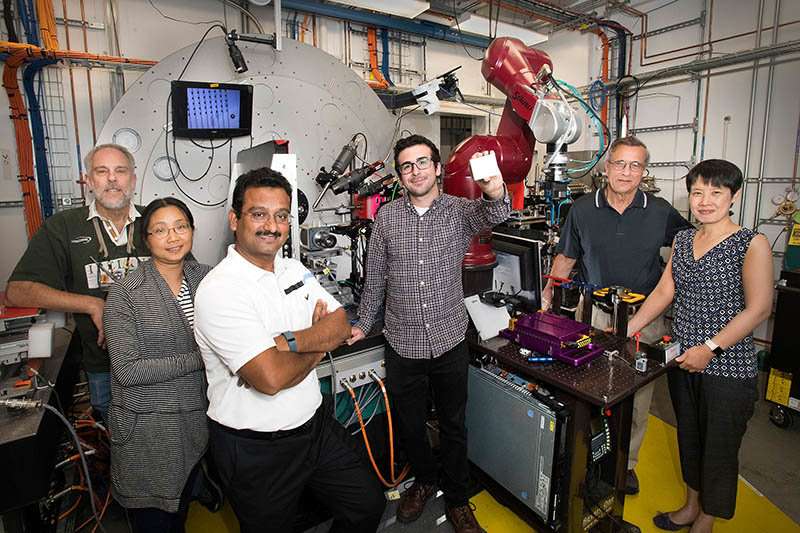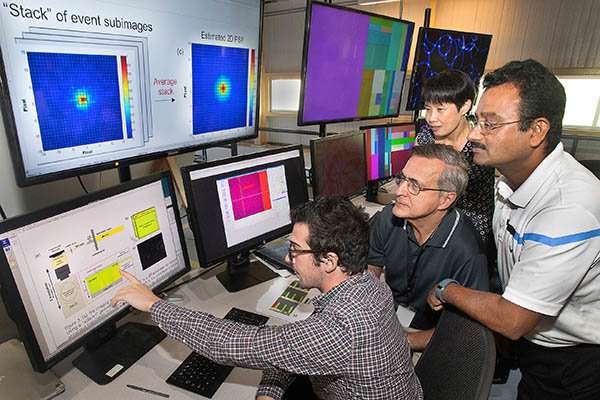Scientists solve fundamental puzzle in medical imaging

Scientists from Stony Brook University have used a novel technique at the National Synchrotron Light Source II (NSLS-II), a U.S. Department of Energy (DOE) Office of Science User Facility located at Brookhaven National Laboratory, to answer longstanding questions in medical imaging.
The research team used individual x-rays to characterize the physics of how light moves within scintillators—a component of x-ray detectors—for the very first time. Their findings could aid the development of more efficient x-ray detectors for improved medical diagnoses.
X-ray imaging is a widespread technique for viewing the internal structures of matter. In the medical field, x-ray imaging is used to generate images of the body's internal structure for diagnostic and interventional purposes. The method works by projecting x-rays though a patient and capturing them with an x-ray detector to produce a "shadow image" of the patient's body. While x-ray imaging works similarly across all its applications, it presents a distinct problem to the medical industry.
"There are competing challenges in medical x-ray imaging," said Adrian Howansky, a Ph.D. candidate at SBU's Health Sciences Center. "You want to detect as many x-rays as possible to produce a high-quality image and make the best diagnosis, but you also need to limit the number of x-rays you put through the patient to minimize their safety risk."
X-rays can be harmful to patients if they are received in large or multiple doses. That's why the SBU team sought to optimize x-ray detectors by understanding the physics of how they work. If they could define the exact way these detectors produce an image, the team could identify methods for improving the images without increasing the number of x-rays sent through the patient. To do this, the scientists studied the most crucial component of the x-ray detector, called the scintillator. This material, whose thickness can be as little as 200 micrometers, is responsible for absorbing x-rays and turning them into bursts of visible light.

"Up until our experiment here at NSLS-II, nobody has been able to precisely describe how light moves within scintillators to form an image," Howansky said.
What scientists did know is that when light bounces around a scintillator before it is detected, it produces "blur" that reduces image resolution. Random variations in that blur can also contribute additional noise to the x-ray image. If this phenomenon could be directly observed and understood, scientists could identify ways to improve the performance of x-ray detectors and the quality of the images they produce—and reduce the number of x-rays needed to make usable images.
The SBU team searched for the sources of this noise by analyzing different types of scintillators at beamline 28-ID-2 at NSLS-II. Using a novel approach, the scientists imaged individual x-rays at known points in the scintillator to eliminate confounding factors.
"By putting single x-rays at precise depths inside of the scintillators, we were able to characterize exactly how light scatters and gets collected from different points of origin. This allows us to pinpoint each source of noise in the images that scintillators make," Howansky said. "We're the first group to be able to directly measure this phenomenon because of the resources at NSLS-II."
Rick Lubinsky, an assistant research professor in radiology at SBU, said, "It's amazing what we are able to do with the help of beamline scientists at NSLS-II. They created the perfect x-ray beam for our research—just the right energy level and just the right shape. The beam was so thin that we could actually move it up and down inside of the scintillator and resolve what was happening. The brightness and intensity of the beam is incredible."
More information: Thomas G. Flohr et al. Direct measurement of Lubberts effect in CsI:Tl scintillators using single x-ray photon imaging, Medical Imaging 2017: Physics of Medical Imaging (2017). DOI: 10.1117/12.2255561
Provided by Stony Brook University




















